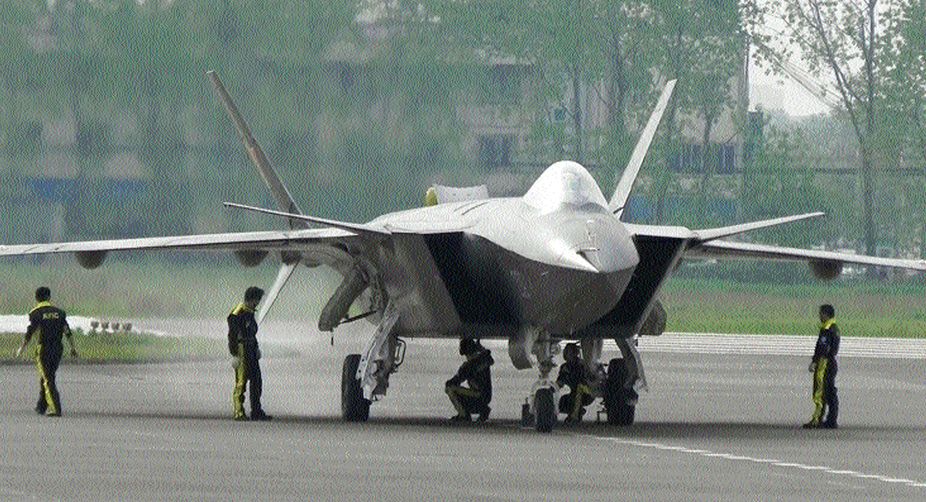The pièce de résistance at the Zhuhai air show in
Guangdong province was the long-awaited Chinese J-20 stealth fighter jet. The
60-second flypast in a first ever, public sneak-preview was the cynosure of the
world as China demonstrated its claim of entering the exclusive club of
countries with “fifth generation” fighter planes. Touted as the only other
operation-ready answer to America’s Lockheed Martin F-22 Raptor (entered
service in 2005) and the Lockheed Martin F-35 (entered service earlier this
year), the J-20 is a strategic statement of intent by the Chinese that suggests
the narrowing down of the critical technology gap with the US, in a fight to
actualise the neologism of the “Chinese Century”.
The diffusion of technology, economic output and
power has reduced the spectre of US unipolarity, especially with the Chinese
claiming to have overtaken the mantle of the largest economy from the US.
Earlier, it was generally accepted that the Chinese were at least two decades
behind the US in terms of military capability, especially in maritime,
aerospace and technological dimensions. Therefore, with its numerical strength
(largest standing army of nearly 2.5 million vis-à-vis the second largest army
of the US with 1.5 million), the Chinese have a robust “defensive” position.
However, its hegemonic ambitions necessitate “offensive” capabilities that call
for exponential advancement in military ware like the J-20 or a navy with
“blue-water” capabilities. However, questions on J-20’s capability and efficacy
remain.
To put it in perspective, the French Rafale (36
bought by India) is a fourth-generation fighter, whose design concepts emanated
in the 70’s and 80’s, like the Eurofighter Typhoon, F/A 18 Hornet, MIG 29/35 or
the Sukhoi-35. The key differentiation in the fifth-generation fighters is the
emphasis on the “all-aspect stealth”, highly integrated systems that enable
networking with other elements and the deployment of advanced avionics and
airframes. So far, the Russians and Chinese are in catch-up mode with their
respective programmes of Sukhoi PAK FA and J-20, as the contending platforms to
the US F-22 or the more recent F-35. Incidentally, India has pegged its need
for a “Fifth-generation” fighter on the success of the Russian Sukhoi PAK FA
(with FGFA or Fifth Generation Fighter Aircraft, envisaged to be co-developed
with HAL as an even superior platform in terms of stealth, super cruise,
avionics and sensors). India is expected to procure 144 of these two-seat
versions, besides 50 original Russian single-seater versions, with the
induction expected to start from 2020.
Advertisement
Virtual undetectability, enhanced lethality and
ability to operate in hostile anti-access environments make these “fifth
generation” fighter planes worth the extreme cost (F-35 programme is supposed
to cost $1.5 trillion, making it the most expensive military weapons system in
the world). The sci-fi abilities include inter-operability to share everything
it can see with other aircraft and operational centres, 360-degree access to
“real-time” combat information, electro-optical targeting systems that deliver
laser and GPS-guided weapons — all this, while remaining undetected!
Concerns over J-20’s ‘stolen’ technology and
inability to fully match up with the US F-22 or the F-35 abound, with questions
on its radar-evading coating, design issues like poorly shielded engines,
avionics on-board or the sensor-fusion capabilities to make it a comparable
“fifth-generation” competitor. It is said that data stolen or hacked from the
American contractors contributed substantially to the development of the
Chinese J-20. US Deputy Defence Secretary Bob Work had conceded that the
Chinese “have stolen information from our defence contractors and it has helped
them develop systems”. J-20 is said to proximate the F-22 platform whereas J-31
(still under development by Shenyang Aircraft Corporation) is said to mirror
F-35.
The J-20’s relatively larger frame vis-à-vis the
American fighters, ought to give it a longer reach with more internal fuel
capacity and a larger weapon carrying bay for missiles and munitions. While it
may not be as stealthy or capable as the US platforms, it is still a quantum
leap in terms of its still hard-to-detect capabilities that could be superior
to anything in the region, be it the current Russian made Sukhois, MiGs or the
Japanese or Indian forays (e.g. the stuttering development of Tejas-LCA). The
Chinese are maintaining that the J-20 would be fully operational by 2018, and
could start induction thereafter. Already the Pakistanis, who are the largest
importers of Chinese arms, have evinced interest to buy the export variant of
the J-20 called the FC-31.
So, while exact details on the specifications and
capabilities are still patchy and doubts over the comparable US offerings will
persist, the J-20 development needs to be noted in terms of the
“reverse-engineering” feat of the Chinese and their ability to rapidly develop
and deliver a weapons platform, ahead of schedule. Even though it is early days
to fully operationalise and functionalise the entire J-20 support system to
make it lethal, there is the threat of Indian BrahMos missiles on the
Sino-Indian border that could bring the Daocheng Yading airport in Tibet within
the “first-wave” hit. We need to recalibrate our future response with the
options of accelerating the joint Indo-Russian FGFA or even considering the
American F-35s which are on order by countries like Israel, Turkey, South Korea
and a host of European countries.
Already, tensions in Asia are rife like never
before: the Middle East and Af-Pak region are caught in a Pan-Islamic fire,
Indo-Pakistani LOC is witnessing unprecedented cross-border hostility, the
North Korean belligerence continues, and the Chinese have upped the ante in the
restive South China Sea with its famed bullying and intimidation tactics that
threaten the sovereignty of nations in the region. Seen in this cauldron, the
J-20 threatens to unbalance the delicate security arrangement with a fresh
imperative towards a corrective arms race. The J-20 may not be a game changer
in capabilities as postured, but it surely is a dangerous spoiler.
–By Bhopinder Singh
The writer is Lt Gen PVSM, AVSM (Retd), Former Lt
Governor of Andaman & Nicobar Islands & Puducherry.
Advertisement











